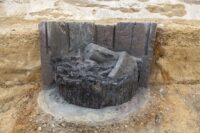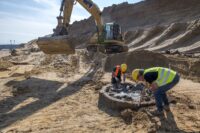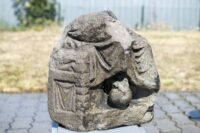 Archaeologists have unearthed a Roman well containing the remains of a column with depictions of Jupiter and three goddesses in a lignite mine in Kerpen, Germany. Columns with figural depictions of this kind from the Roman era are extremely rare in the Rhineland. The well was exposed when the opencast mine pit was 50 feet deep.
Archaeologists have unearthed a Roman well containing the remains of a column with depictions of Jupiter and three goddesses in a lignite mine in Kerpen, Germany. Columns with figural depictions of this kind from the Roman era are extremely rare in the Rhineland. The well was exposed when the opencast mine pit was 50 feet deep.
The timber-sided well and its fill were discovered in the Hambach mine and archaeologists from the Rhineland Regional Council’s Office for Monument  Preservation in the Rhineland (LVR-ABR) called in to excavate it. Inside they found the remains of marble carving of Jupiter seated on a throne. It was heavily damaged with only the throne and lower body of the god extant, but its dimensions indicate the column was around 16 feet high when intact.
Preservation in the Rhineland (LVR-ABR) called in to excavate it. Inside they found the remains of marble carving of Jupiter seated on a throne. It was heavily damaged with only the throne and lower body of the god extant, but its dimensions indicate the column was around 16 feet high when intact.
A relief at the foot of the column is also believed to depict Jupiter, but it too is damaged enough to make identification tentative. Another relief carved around a cylindrical drum shows three goddesses: Juno, consort of Jupiter,  Minerva, goddess of wisdom and an extremely rare depiction of Nemesis-Diana, a composite of the goddess of vengeance and the goddess of the hunt. She is identifiable as such because she wears the short dress of Diana and is accompanied by a wagon wheel, an attribute of Nemesis. There is evidence of the worship of Nemesis-Diana in the Roman Empire, but iconographic representations are scarce. This is the first one ever discovered in the Rhineland.
Minerva, goddess of wisdom and an extremely rare depiction of Nemesis-Diana, a composite of the goddess of vengeance and the goddess of the hunt. She is identifiable as such because she wears the short dress of Diana and is accompanied by a wagon wheel, an attribute of Nemesis. There is evidence of the worship of Nemesis-Diana in the Roman Empire, but iconographic representations are scarce. This is the first one ever discovered in the Rhineland.
 The remains of Jupiter columns have been found before on Roman villas in Germany. Archaeologists believe they probably adorned the courtyards of wealthy homes. The quality of construction of the well suggests it too was part of luxury estate. Its foundation is composed of large sandstones each weighing several tons. They had to be transported to the site. The cost of moving such large stones would have been exorbitant and affordable only to the elite.
The remains of Jupiter columns have been found before on Roman villas in Germany. Archaeologists believe they probably adorned the courtyards of wealthy homes. The quality of construction of the well suggests it too was part of luxury estate. Its foundation is composed of large sandstones each weighing several tons. They had to be transported to the site. The cost of moving such large stones would have been exorbitant and affordable only to the elite.
Similar wells found in the area mostly date to the 2nd and 3rd centuries. Ceramic fragments found in the backfill of the well indicate that it was in  use until the 5th century. It’s hard to say when the Jupiter column parts were deposited in the well. It could have been as early as the 3rd century, perhaps as a result of destruction wrought by Germanic invasions, or the representations of Roman deities might have been damaged and drowned by Christians in late antiquity. Archaeologists hope the well-preserved wood elements of the well will provide an absolute date on its construction.
use until the 5th century. It’s hard to say when the Jupiter column parts were deposited in the well. It could have been as early as the 3rd century, perhaps as a result of destruction wrought by Germanic invasions, or the representations of Roman deities might have been damaged and drowned by Christians in late antiquity. Archaeologists hope the well-preserved wood elements of the well will provide an absolute date on its construction.